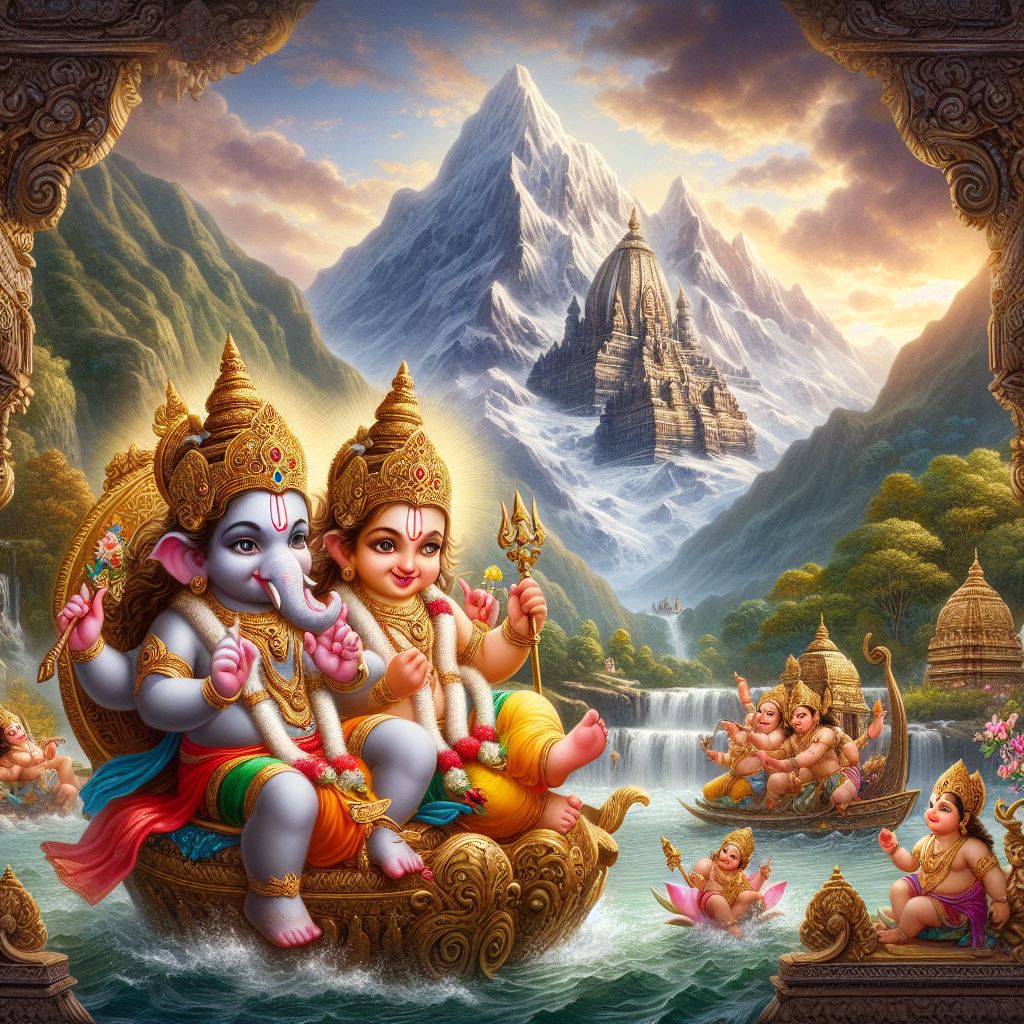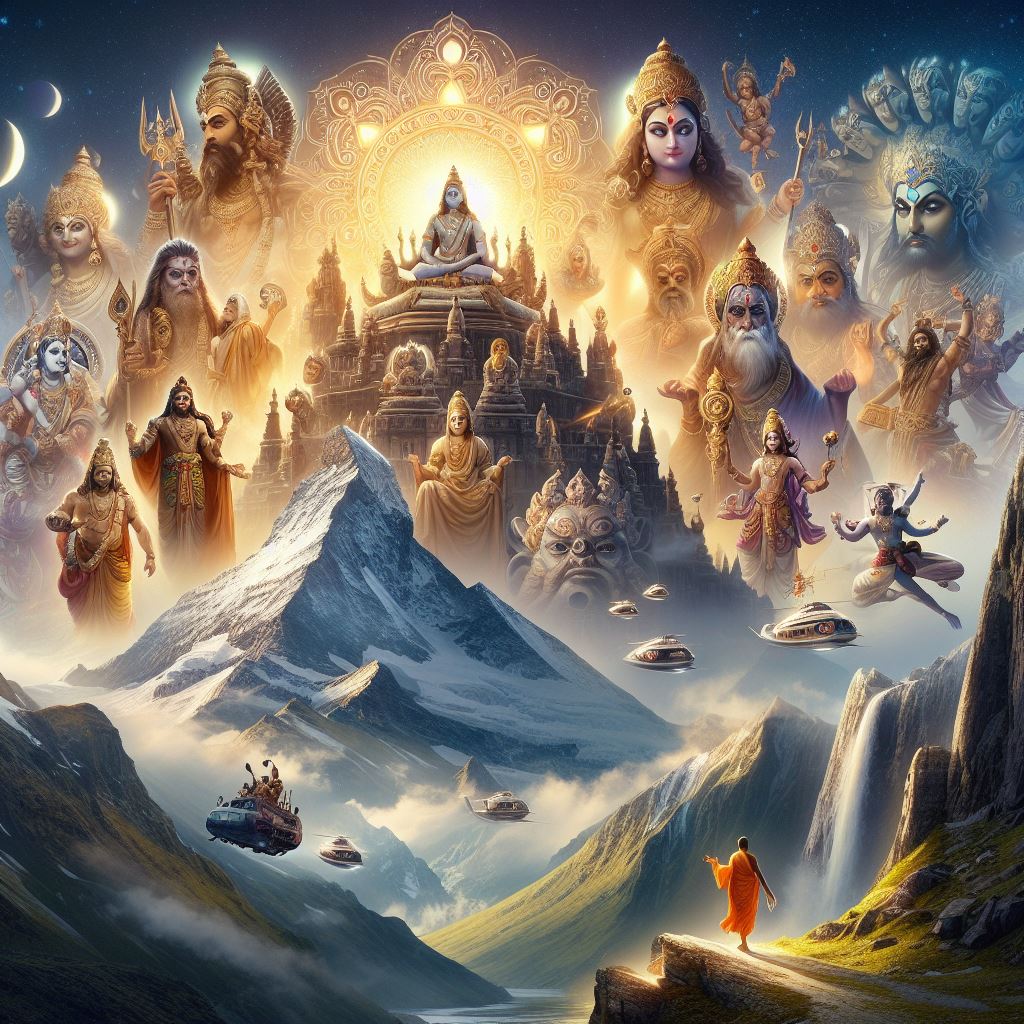The Dates when the Yugas and Manvantaras Begin
In this article we will learn about The Dates When Yugas and Manvantaras Begin
The Dawn of the Yuga-s
In the grand tapestry of Hindu cosmology, time unfolds in cyclical epochs known as the Yugas. These epochs mark distinct phases in the evolution of human consciousness, from a golden age of spiritual enlightenment to darker times of moral decline.
According to ancient scriptures, the Yugas follow a precise order, each characterized by its unique attributes and durations. The sacred texts provide specific details regarding the commencement dates of the Yugas, offering a glimpse into the cosmic rhythm of creation.
- Krita Yuga: The first and most auspicious age, also known as the Age of Truth, begins on the first day of the bright half of the month of Māgha.
- Treta Yuga: Following the Satya Yuga is the Treta Yuga, an age marked by a gradual decline in virtue and righteousness. Its inception occurs on the third day of the bright half of the month of Caitra.
- Dvapara Yuga: Subsequent to the Treta Yuga is the Dvapara Yuga, an age characterized by increasing moral ambiguity and spiritual ignorance. It begins on the twelfth day of the bright half of the month of Kārttika.
- Kali Yuga: The final and darkest age, the Kali Yuga, is an epoch defined by moral decadence, spiritual degradation, and widespread suffering. Its advent takes place on the eighth day of the dark half of the month of Āṣāḍha.
These first days of the Yugas are known as the days causing everlasting benefits if charitable gifts are offered (on these days). One should know thāt gifts made and Havanas (i.e. Fire worship, oblations to gods) performed on these four Yugādi days (‘first days of the Yugas’) yield ever-lasting benefits. Charitable gifts made over a period of hundred years in the course of a Yuga and those made on a single day, i.e. on the first day are of equal benefits.
As humanity traverses the cycles of the Yugas, it experiences the ebb and flow of spiritual consciousness, oscillating between periods of enlightenment and ignorance. Yet, amidst the flux of time, the eternal truths of dharma (righteousness), karma (action), and moksha (liberation) endure, guiding seekers on the path towards inner awakening and transcendence.
Thus, the journey of the soul unfolds across the vast expanse of cosmic time, propelled by the eternal quest for truth and liberation.
The first days of the Yugas have been described. Now listen to the first days of the Manvantaras.
The Dawn of the Manvantara-s
In the vast expanse of cosmic time, the epochs of the Yugas are further subdivided into larger periods known as Manvantaras. Each Manvantara is presided over by a specific Manu, the progenitor of humanity, who guides the destinies of mortals with wisdom and compassion.
The scriptures provide precise details regarding the commencement dates of the Manvantaras, offering insight into the cosmic tapestry of creation. The order of the Manvantaras and their starting dates are delineated as follows:
- The ninth day of the bright half of the month of Aśvayuj,
- The twelfth day (of the bright half) of Kārttika,
- The third day of the bright half of the month of Caitra,
- The third day of the bright half of the month of Bhādrapaḍa,
- The new-moon day in the month of Phālguna,
- The eleventh day of (the bright half of) the month of Pauṣa,
- The tenth day of the month of Āṣāḍha,
- The seventh day of the month of Māgha,
- The eighth day of the dark half of the month of Śrāvaṇa,
- The full-moon day of the month of Āṣāḍha,
- The full-moon day in the month of Kārttika,
- The full-moon day of the month of Phālguna,
- The full-moon day of the month of Caitra, and
- The full-moon day of the month of Jyeṣṭha.
These are the first days of the Manvantaras causing everlasting benefits for the charitable gifts made on these days.
The cyclical nature of time, the impermanence of worldly existence, and the timeless quest for spiritual enlightenment. And amidst the ever-changing tides of fate, the eternal flame of hope burns bright, guiding humanity towards the path of righteousness and divine realization.
*****
For most of the Hindus, the above information would be sufficient, and thus this article ends here. However, for those Hindus who are inclined to learn these truths referencing the direct quotations from the scriptures, may refer the below block for scriptural references.
The Scriptural References
One day sage Nārada roams all over the world asking the learned Brāhmaṇa-s a bunch of questions, which none of them could answer. Finally, he reaches a village named, ‘Kalāpa’, abound with highly learned scholars. There, he presents his questions to all of them. Here we would see only two of those questions.
Nārada inquires them to tell if they can, about the date when the four Yuga-s commence in every cycle. Likewise, he also asks them to mention, if they know, about the day when the fourteen Manvantara-s begin.
“नारद उवाच।
युगानां च चतुर्णां वा को मूलदिवसान्वदेत्॥
चतुर्दशमनूनां वा मूलवासरं वेत्ति कः।” (Skanda Purana 1:2:05:25b-26a)
“Narada enquired: Who will tell the ‘root’ days (i.e. the days of the beginning) of the four Yugasl? Who knows the ‘root’ days (i.e. the first day of the advent of each Manvantara) of fourteen Manus? “.
A mere boy of name ‘Sutanu’ answers his questions. Describing the dates when the four Yuga-s always begin he replies saying:
- “नवमी कार्तिके शुक्ला कृतादिः परिकीर्तिता॥ (verse 121)”, meaning, “The ninth day in the bright half of the month of Kārttika is glorified as the first day of Kṛtayuga.”
- “वैशाखस्य तृतीया या शुक्ला त्रेतादिरुच्यते॥ (verse 122)”, meaning, “The third day in the bright half of the month of Vaiśākha is said to be the first day of Tretāyuga.”
- “माघे पञ्चदशीनाम द्वापरादिः स्मृता बुधैः॥ (verse 122)”, meaning, “The new-moon day in the month of Māgha is known by learned men as the first day of Dvāparayuga.”
- “त्रयोदशी नभस्ये च कृष्णा सा हि कलेः स्मृता॥ (verse 123)”, meaning, “The thirteenth day in the dark half of the month of Bhādrapada is known as the first day of Kali.”
Any meritorious deed such as gifting or charity done on these dates of ‘Yugādi’ accords the giver with an inexhaustible fruition of religious merit.
“युगादयः स्मृता ह्येता दत्तस्याक्षयकारकाः॥123
एताश्चतस्रस्तिथयो युगाद्या दत्तं हुतं चाक्षयमाशु विद्यात्॥
युगेयुगे वर्षशतेन दानं युगादिकाले दिवसेन तत्फलम्॥” (Skanda Purana 1:2:05:123b-124)
“These first days of the Yugas are known as the days causing everlasting benefits if charitable gifts are offered (on these days). One should know thāt gifts made and Havanas (i.e. Fire worship, oblations to gods) performed on these four Yugādi days (‘first days of the Yugas’) yield ever-lasting benefits. Charitable gifts made over a period of hundred years in the course of a Yuga and those made on a single day, i.e. on the first day are of equal benefits”.
Likewise, in reply to the question on Manvantara-s, the boy named Sutanu responds recounting the names of the fourteen Manu-s as follows.
“स्वायंभुवश्च स्वारोचिरौत्तमो रैवतस्तथा॥
तामसश्चाक्षुषः षष्ठस्तथा वैवस्वतोऽधुना॥ ५.७२ ॥
सावर्णिर्ब्रह्मसावर्णी रुद्रसावर्णिरेव च॥
दक्षसावर्णिरेवापि धर्मसावर्णिरेव च॥ ५.७३ ॥
रौच्यो भौत्यस्तथा चापि मनवोऽमी चतुर्दश॥” (Skanda Purana 1:2:05:72-74a)
“They are Svāyaṃbhuva, Svārocis, Auttama, Raivata, Tāmasa, Cākṣuṣa the sixth one, Vaivasvata the current one, Sāvarṇi, Brahmasāvarṇi, Rudrasāvarṇi, Dakṣasāvarṇi, Dharmasāvarṇi, Raucya and Bhautya”.
Accordingly, the Manvantara-s which follow the same sequence, after the names of the fourteen Manu-s, have different dates of their beginning which are described by Sutanu as follows:
“अश्वयुक्छुक्लनवमी द्वादशी कार्तिके तथा॥125
तृतीया चैत्रमासस्य तथा भाद्रपदस्य च।
फाल्गुनस्य त्वमावास्या पौषस्यैकादशी तथा॥126
आषाढस्यापि दशमी माघमासस्य सप्तमी।
श्रावणस्याष्टमी कृष्णा तथाषाढी च पूर्णिमा॥127
कार्तिकी फाल्गुनी चैत्री ज्येष्ठे पञ्चदशी सिता।” (Skanda Purana 1:2:05:125-b-128a)
“The order is the same as that of the Manvantaras mentioned before: (1) The ninth day of the bright half of the month of Aśvayuj, (2) the twelfth day (of the bright half) of Kārttika, (3) the third day of the bright half of the month of Caitra, (4) the third day of the bright half of the month of Bhādrapaḍa, (5) the new-moon day in the month of Phālguna, (6) the eleventh day of (the bright half of) the month of Pauṣa, (7) the tenth day of the month of Āṣāḍha, (8) the seventh day of the month of Māgha, (9) the eighth day of the dark half of the month of Śrāvaṇa, (10) the full-moon day of the month of Āṣāḍha, (11) the full-moon day in the month of Kārttika, (12) the full-moon day of the month of Phālguna, (13) the full-moon day of the month of Caitra, and (14) the full-moon day of the month of Jyeṣṭha”.
Any meritorious deed such as donations etc., done on these dates accord the giver with an inexhaustible fruition of religious merit.
“मन्वंतरादयश्चैता दत्तस्याक्षयकारकाः॥” (Skanda Purana 1:2:05:128b)
“These are the first days of the Manvantaras causing everlasting benefits for the charitable gifts made on these days”.
And this is how the boy named Sutanu proves the merit of his high intellect by answering correctly to the questions posed by Nārada!
FAQ-s:
This article answers the following list of frequently asked questions:
- What is meant by Yugadi?
- What is meant by Manvantaradi?
- What are the spiritual benefits of religious observances on Yugadi?
- On what dates the Yuga-s begin
- On what dates the Manvantara-s begin?



